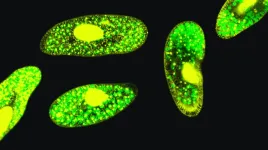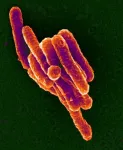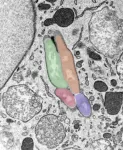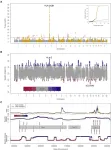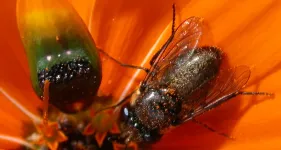(Press-News.org) Microplastic pollution reduces energy production in a microscopic creature found in freshwater worldwide, new research shows.
Paramecium bursaria contain algae that live inside their cells and provide energy by photosynthesis.
The new study, by the University of Exeter, tested whether severe microplastic contamination in the water affected this symbiotic relationship.
The results showed a 50% decline in net photosynthesis – a major impact on the algae’s ability to produce energy and release oxygen.
“The relationship I examined – known as photosymbiosis – is commonly found both in freshwater and the oceans,” said Dr Ben Makin, lead author and associate researcher at the Environment and Sustainability Institute on Exeter’s Penryn Campus in Cornwall.
“We know climate change can damage photosymbiotic relationships, including in corals (leading to ‘bleaching’ events).
“Recent studies have shown that microplastics (plastic particles smaller than 5 mm) may also interfere with photosymbiosis – but more research is needed, especially in freshwater habitats.
“In this study, I chose a ‘classic’ example of photosymbiosis – Paramecium bursaria are found in freshwater around the world, and similar symbiotic relationships exist in the oceans.”
The study placed Paramecium bursaria in water contaminated with microplastics in the laboratory.
The level of contamination was higher than that usually seen in the natural world, but it has been found in some places.
“At this stage, the question I wanted to answer was whether severe contamination could affect this important relationship – and what those effects might be,” Dr Makin explained.
“This is a pilot experiment, and more research is needed to test different microplastic concentrations, different kinds of plastic and the effects on different species.”
The findings do not reveal how microplastics caused the observed impacts on photosymbiosis. Possibilities include Paramecium bursaria ingesting plastic particles, and/or chemicals from the plastics affecting biological processes.
The study tracked the impact of microplastics (compared to control water samples with no microplastics) on growth rate, symbiont density (how many algae were in each Paramecium bursaria), metabolic rate, feeding rate and net photosynthesis.
Only net photosynthesis was significantly affected – but this could be important, as it provides the organism with energy and underpins the “trade” in nutrients that allows the photosymbiosis to persist.
Strikingly, this type of association is responsible for a great deal of photosynthesis worldwide – roughly half of all photosynthesis in the ocean is underpinned by photosymbiosis.
“The findings could raise concern for the important contributions of photosymbiosis to primary production at a global level,” Dr Makin explained.
“Microplastics are a widespread contaminant, and their impacts on photosymbiosis – especially in freshwater – remain quite poorly characterised.”
The paper, published in the journal Aquatic Biology, is entitled: “Microplastic contamination reduces productivity in a widespread freshwater photosymbiosis.”
END
Microplastics limit energy production in tiny freshwater species
2023-03-23
ELSE PRESS RELEASES FROM THIS DATE:
SwRI, JPL study suggests explanation for unusual radar signatures of icy satellites in the outer solar system
2023-03-23
SAN ANTONIO — March 23, 2023 —A study co-authored by Southwest Research Institute Senior Research Scientist Dr. Jason Hofgartner explains the unusual radar signatures of icy satellites orbiting Jupiter and Saturn. Their radar signatures, which differ significantly from those of rocky worlds and most ice on Earth, have long been a vexing question for the scientific community.
“Six different models have been published in an attempt to explain the radar signatures of the icy moons that orbit Jupiter and Saturn,” said Hofgartner, first author of the study, ...
Harnessing power of immune system may lessen reliance on antibiotics for infections like TB
2023-03-23
Francis Crick Institute press release
Under strict embargo: 16:00 GMT 23 March 2023
Peer reviewed
Experimental study
Human stem cells
Researchers at the Francis Crick Institute have found that the body’s process of removing old and damaged cell parts, is also an essential part of tackling infections that take hold within our cells, like TB.
If this natural process can be harnessed with new treatments, it could present an alternative to, or improve use of antibiotics, especially where bacteria have become ...
Newly discovered cell in fruit flies is essential for touch sensation
2023-03-23
The Francis Crick Institute press release
Under strict embargo: 16:00 GMT Thursday 23rd March
Peer reviewed
Experimental
Cells
Researchers at the Francis Crick Institute have uncovered a key role for a new type of cell in touch detection in the skin of the fruit fly.
Touch allows animals to navigate their environment by gathering information from the outside world. In their study published today in Nature Cell Biology, Dr Federica Mangione and Dr Nicolas Tapon shed light on how touch-sensitive organs assemble during development.
In particular the team studied the development ...
Researchers discover a way to fight the aging process and cancer development
2023-03-23
A protein complex prevents the repair of genome damage in human cells, in mice and in the nematode Caenorhabditis elegans, a team of researchers at the University of Cologne has discovered. They also successfully inhibited this complex for the first time using a pharmaceutical agent.
“When we suppress the so-called DREAM complex in body cells, various repair mechanisms kick in, making these cells extremely resilient towards all kinds of DNA damage,” said Professor Dr Björn Schumacher, Director of the Institute for Genome Stability in Aging ...
A new, sustainable source for a promising cancer killer
2023-03-23
Plants produce all types of curious chemicals. Some deter predators. Some smell wonderful. Some even have medicinal value. One of these hidden gems is (–)-jerantinine A (JA), a molecule with remarkable anticancer properties, produced by a plant called Tabernaemontana corymbosa. Unfortunately, access to this Malaysian jungle plant and its promising chemical compound has been limited. Until now.
Cold Spring Harbor Laboratory (CSHL) chemists, led by Professor John E. Moses, have created a way to safely, quickly, and sustainably synthesize JA in the lab. To cancer biologists at CSHL, this breakthrough could mean future ...
Disparities in the research effort to combat animal-borne diseases amid climate change
2023-03-23
Whether it’s diseases from bats, birds, pigs, or mosquitoes, climate change brings with it an increased risk of animal-borne (or “zoonotic”) diseases that can transmit to humans.
Digital Science, a technology company serving stakeholders across the research ecosystem, has today released its analysis of the global research response to climate change and zoonotic diseases, in the context of the United Nations’ Sustainable Development Goals (SDGs) on climate and health.
Using data from Dimensions, Dr Briony Fane, Ann Campbell and Dr Juergen Wastl from Digital Science have explored published research, ...
Patient-specific cells generated from thymus organoids
2023-03-23
Researchers have used pluripotent stem cells to make thymus organoids that support the development of patient-specific T-cells, researchers report March 23rd in the journal Stem Cell Reports. The proof-of-concept work provides the basis for studying human thymus function, T-cell development, and transplant immunity.
“We have established the framework for further basic science and translational research interrogating human thymus development and function in vitro, and in a patient-specific manner,” says senior author Holger Russ, of the University ...
Early European farmers borrowed genes from hunter-gatherers to survive disease
2023-03-23
When early Stone Age farmers first moved into Europe from the Near East about 8,000 years ago, they met and began mixing with the existing hunter-gatherer populations. Now genome-wide studies of hundreds of ancient genomes from this period show more hunter-gatherer ancestry in adaptive-immunity genes in the mixed population than would be expected by chance.
The findings, reported in Current Biology on March 23, suggest that mixing between the two groups resulted in mosaics of genetic variation that were acted upon by natural selection, a process through which all organisms, including humans, adapt and change ...
Deceptive daisy’s ability to create fake flies explained
2023-03-23
A male fly approaches a flower, lands on top of what he thinks is a female fly, and jiggles around. He’s trying to mate, but it isn’t quite working. He has another go. Eventually he gives up and buzzes off, unsuccessful. The plant, meanwhile, has got what it wanted: pollen.
A South African daisy, Gorteria diffusa, is the only daisy known to make such a complicated structure resembling a female fly on its petals. The mechanism behind this convincing three-dimensional deception, complete ...
Ancient genomes reveal immunity adaptation in early farmers
2023-03-23
Francis Crick Institute press release
Under strict embargo: 15:00hrs GMT 23 March 2023
Peer reviewed
Observational study
People
Research from the Francis Crick Institute published today in Current Biology has revealed that diversity in genes coding for immunity may have facilitated adaptation to farming lifestyles in prehistoric periods.
Researchers at the Ancient Genomics Laboratory at the Crick studied available genome-wide DNA from 677 individuals dating to Stone Age Europe, spanning the movement of Neolithic farmers from the Near East into Europe about 8000 years ago, where they mixed with Mesolithic hunter-gatherers already in Europe.
They were interested in whether ...
